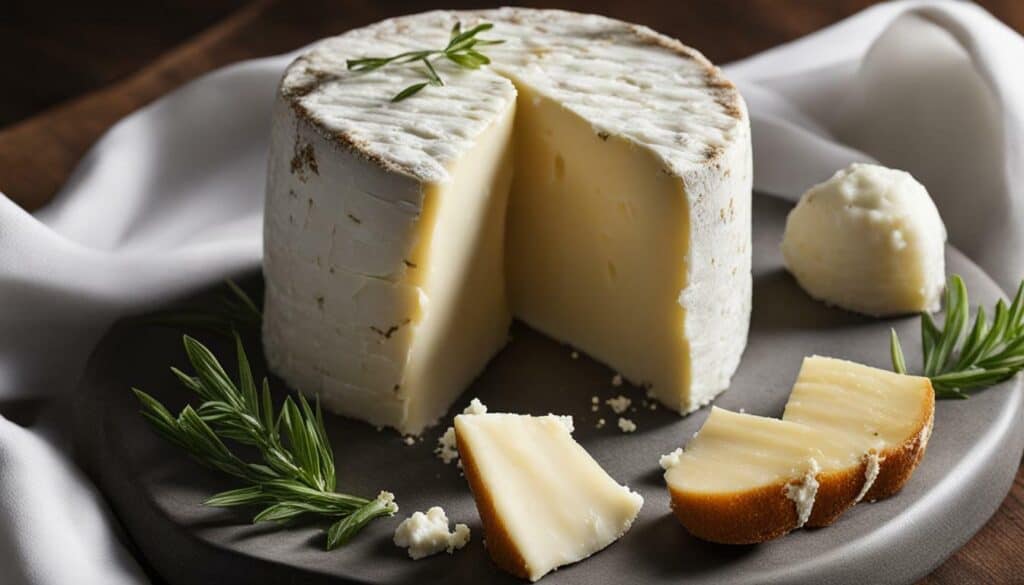Eggs with cheese make for a delicious and satisfying breakfast option, but have you ever wondered about the calorie content and nutritional value of this popular dish? In this section, we will explore the surprising facts about calories in eggs with cheese and discuss their nutritional value.
Key Takeaways:
- Research shows that moderate egg consumption is not associated with increased heart disease risk in healthy individuals.
- Individuals with high cholesterol or blood pressure should use high-fat cheeses sparingly.
- Reduced-fat cheeses can be a good alternative, as they provide less saturated fat.
- Other sources of calcium and protein include low-fat yogurt, tinned fish, tofu, lentils, and beans.
- Claims about cheese being addictive are inconclusive.
While eggs with cheese can be enjoyed in moderation as part of a healthy diet, it’s important to consider portion sizes and choose cheese options that are lower in fat. By being mindful of your choices and incorporating a variety of calcium and protein sources, you can still savor the deliciousness of this classic breakfast dish while maintaining a balanced lifestyle.
The Truth about Eggs and Cholesterol
The relationship between eggs, cholesterol, and weight loss has long been a topic of discussion, and it’s time to uncover the truth. While eggs have been vilified in the past for their high cholesterol content, research shows that moderate egg consumption is not associated with increased heart disease risk in healthy individuals. In fact, eggs are packed with essential nutrients like protein, vitamins, and minerals, making them a valuable addition to a balanced diet.
For those concerned about cholesterol, it’s important to note that the cholesterol in our diet has less impact on blood cholesterol levels than previously thought. The body produces cholesterol naturally, and when we consume cholesterol from foods like eggs, it adjusts its production accordingly. Therefore, moderate egg consumption is unlikely to significantly raise cholesterol levels in most people.
However, individuals with high cholesterol or blood pressure should use high-fat cheeses sparingly, as they can contribute to these conditions. Reduced-fat cheeses can be a good alternative, as they provide less saturated fat. It’s also important to eat cheese in moderation and consider other sources of calcium and protein, such as low-fat yogurt, tinned fish, tofu, lentils, and beans. It’s a misconception that reduced-fat cheese is tasteless, as there are options available that are flavorful.

When it comes to incorporating eggs and cheese into a weight loss plan, portion control and wise choices are key. While there have been claims about cheese being addictive, the evidence is inconclusive. Cheese is a good source of calcium, but other dairy products like yogurt and milk are equally beneficial for bone health. Goat’s cheese is not necessarily better for you than cow’s cheese, as it can still be high in fat and salt. Grating cheese onto dishes like spaghetti bolognese adds extra calories, saturated fat, and salt, so it’s important to watch portion sizes. Grated cheese may lead to using less, but it’s still essential to monitor intake.
In conclusion, eggs and cheese can be enjoyed in moderation as part of a healthy diet. They provide essential nutrients and can be a valuable addition to a weight loss plan. However, it’s important to make wise choices, opt for reduced-fat cheeses, and consider other sources of calcium and protein. By incorporating these foods mindfully, you can enjoy the benefits they offer while maintaining a balanced and nutritious eating pattern.
Choosing the Right Cheese for a Healthy Breakfast
The cheese you choose to pair with your eggs can significantly impact the healthiness of your breakfast, so let’s explore the options. When selecting cheese, it’s important to consider factors like fat content, nutritional value, and taste. While cheese can be a delicious addition to your meal, it’s essential to make informed choices that align with your health goals. Here are some tips to help you choose the right cheese for a healthy breakfast:
- Opt for reduced-fat cheeses: Reduced-fat cheeses are a great option if you’re looking to cut back on saturated fat. These cheeses provide the same creamy texture and flavor but with fewer calories and less unhealthy fat. Look for labels that indicate reduced-fat or low-fat options.
- Consider the nutritional value: Some cheeses, like cheddar and Swiss, are good sources of calcium and protein. However, they can also be high in sodium and saturated fat. To promote a balanced diet, it’s important to choose cheese varieties that offer nutritional benefits without tipping the scales in unhealthy directions. Feta cheese, for example, is lower in calories and fat than some other cheeses, making it a healthier choice.
- Experiment with different flavors: Don’t be afraid to try new cheese varieties to enhance the taste of your eggs. From tangy goat cheese to creamy mozzarella, there are countless options to explore. By incorporating a variety of flavors, you can keep your breakfast exciting and satisfying.
Remember, while cheese can be a nutritious addition to your breakfast, it’s important to enjoy it in moderation. The calories in cheese can add up quickly, especially if you’re using large portions. To control your portion sizes, try using pre-portioned slices or grated cheese. This can help you limit your intake while still savoring the flavor.
Incorporating eggs with cheese into your breakfast routine can be a delicious and nutritious way to start your day. By choosing the right cheese and controlling portion sizes, you can enjoy a healthy breakfast that satisfies your taste buds and supports your overall well-being.

| Cheese Variety | Calories per ounce | Saturated Fat (grams) | Sodium (milligrams) |
|---|---|---|---|
| Cheddar | 110 | 6 | 180 |
| Swiss | 106 | 7 | 59 |
| Feta | 75 | 5 | 325 |
| Goat Cheese | 75 | 5 | 125 |
| Mozzarella | 85 | 4 | 190 |
Understanding Cheese and its Impact on Health
When it comes to cheese, there’s more to consider than just its calorie count – let’s take a closer look at its nutrition facts. While cheese is often associated with high fat and sodium content, it also offers several nutritional benefits. Cheese is a good source of calcium, which is vital for strong bones and teeth. It also provides protein, essential for muscle growth and repair. Additionally, cheese contains vitamins such as vitamin A, B12, and D, as well as minerals like phosphorus and zinc.
However, not all cheeses are created equal in terms of their impact on health. Full-fat cheeses tend to be higher in saturated fat, which can contribute to an increased risk of heart disease when consumed in excess. Individuals with high cholesterol or blood pressure should exercise caution when consuming high-fat cheeses and opt for reduced-fat alternatives instead. Reduced-fat cheeses still offer the same nutritional benefits but with less saturated fat.
Choosing the Right Cheese for a Healthy Breakfast
When incorporating cheese into a healthy breakfast, it’s important to choose the right type. Consider low-fat or reduced-fat options that still provide flavor without compromising on nutritional value. For example, low-fat cheddar or mozzarella can be excellent choices for omelets or breakfast burritos. These cheeses melt well and add a creamy, savory element to your morning meal.
For those looking to reduce their cheese intake, there are plenty of other sources of calcium and protein to consider. Low-fat yogurt, tinned fish like salmon or sardines, tofu, lentils, and beans are all nutritious alternatives. These options offer a variety of flavors and textures, ensuring a satisfying breakfast without relying solely on cheese.
| Cheese Type | Calories per 1 oz (28g) | Saturated Fat (g) | Sodium (mg) |
|---|---|---|---|
| Full-fat cheddar | 113 | 6.5 | 174 |
| Reduced-fat cheddar | 80 | 4.5 | 203 |
| Low-fat mozzarella | 72 | 2.9 | 176 |
Remember, while cheese can be enjoyed as part of a healthy diet, it’s crucial to consume it in moderation. Managing portion sizes is key to prevent excessive calorie intake, especially when grating cheese onto dishes. The added calories, saturated fat, and salt from grated cheese can quickly accumulate, so it’s important to be mindful of how much you use. Ultimately, by making informed choices and balancing your cheese consumption with other nutritious foods, you can enjoy the benefits it offers without compromising your health.

Exploring Cheese Alternatives for Health-conscious Individuals
If you’re looking to cut down on cheese in your diet, there are plenty of other options that can provide similar nutritional benefits. While cheese is a great source of calcium and protein, it’s not the only option available. Incorporating a variety of foods into your diet can help ensure you’re getting all the nutrients your body needs.
Here are some cheese alternatives to consider:
- Low-fat Yogurt: Yogurt is an excellent source of calcium and protein. Opt for low-fat or Greek yogurt, which is lower in saturated fat and higher in protein.
- Tinned Fish: Fish like salmon and sardines are not only high in protein but also rich in omega-3 fatty acids, which are beneficial for heart health.
- Tofu: Tofu is a versatile plant-based protein that can be used in a variety of dishes. It’s also a good source of calcium.
- Lentils and Beans: Legumes like lentils and beans are high in protein, fiber, and various vitamins and minerals. They can be a great addition to salads, soups, and stews.

Reducing your cheese consumption doesn’t mean sacrificing flavor. There are reduced-fat cheese options available that are just as flavorful as their full-fat counterparts. These cheeses can still be enjoyed in moderation while providing a lower calorie and saturated fat content.
Don’t Forget About Moderation
While exploring cheese alternatives, it’s important to remember that moderation is key. Cheese can still be enjoyed in small amounts as part of a balanced diet. Keep an eye on portion sizes and opt for lower-fat options when possible.
Table: Nutritional Comparison of Cheese Alternatives
| Cheese Alternative | Calories (per 100g) | Protein (g) | Calcium (mg) | Saturated Fat (g) |
|---|---|---|---|---|
| Reduced-fat Cheddar | 200 | 25 | 600 | 5 |
| Low-fat Yogurt | 60 | 6 | 200 | 1 |
| Tofu | 80 | 8 | 350 | 1 |
| Lentils | 115 | 9 | 50 | 0 |
Remember, finding the right balance in your diet is key to maintaining a healthy lifestyle. Incorporating a variety of cheese alternatives can help you reduce your cheese intake while still enjoying delicious and nutritious meals.
Debunking Common Cheese Myths
It’s time to separate fact from fiction when it comes to common myths surrounding cheese and its place in a healthy diet. While there has been speculation about the addictive properties of cheese, the evidence is inconclusive. Cheese can indeed be enjoyed in moderation as part of a balanced eating plan. Let’s explore some of the most prevalent myths and unveil the truth behind them.
Myth #1: Reduced-fat cheese is tasteless and not worth eating.
The truth is that there are many flavorful options of reduced-fat cheese available today. These varieties offer a satisfying taste while providing less saturated fat. So, if you’re watching your fat intake, don’t shy away from trying them and enjoying the benefits they bring.
Myth #2: Goat’s cheese is always a healthier choice than cow’s cheese.
Contrary to popular belief, goat’s cheese is not inherently better for you than cow’s cheese. While it may have a slightly different nutritional profile, it can still be high in fat and salt. So, it’s essential to read the labels and choose options that fit your dietary needs.
Common Cheese Myths Debunked:
- Reduced-fat cheese is tasteless and not worth eating.
- Goat’s cheese is always a healthier choice than cow’s cheese.
“Cheese is a delicious addition to a healthy diet when consumed in moderation, and there are many flavorful options of reduced-fat cheese available today.”
| Myth | Reality |
|---|---|
| Reduced-fat cheese is tasteless and not worth eating. | There are many flavorful options of reduced-fat cheese available, which provide less saturated fat. |
| Goat’s cheese is always a healthier choice than cow’s cheese. | Goat’s cheese can still be high in fat and salt. Choosing the right type of cheese is essential. |

Finally, it’s important to monitor portion sizes when indulging in cheese. Grating cheese onto dishes like spaghetti bolognese may add extra calories, saturated fat, and salt. Although grated cheese can help control intake, it’s essential to be mindful of the quantities consumed.
Remember, cheese is just one of the many sources of calcium and protein available. Low-fat yogurt, tinned fish, tofu, lentils, and beans are also excellent options for meeting your nutritional needs. By incorporating a variety of foods into your diet, you can enjoy the benefits of eating eggs with cheese while maintaining a well-rounded and health-conscious lifestyle.
Optimizing Portion Sizes to Enjoy Cheese in Moderation
Incorporating eggs with cheese into your diet doesn’t have to mean sacrificing portion control – here’s how to strike a balance. While cheese can be a delicious addition to any meal, it’s important to be mindful of portion sizes to ensure you’re getting the nutritional benefits without consuming excess calories, saturated fat, and sodium.
To manage your portion sizes, consider using the following strategies:
- Measure your cheese: Use a kitchen scale or measuring cups to accurately portion out your cheese. Stick to the recommended serving sizes to avoid overindulging.
- Choose smaller quantities: Opt for smaller and thinner slices or shreds of cheese to add flavor to your dishes without going overboard.
- Pair with other ingredients: Mix your cheese with vegetables, whole grains, or lean proteins to create a well-balanced meal. This can help reduce the amount of cheese you consume while still enjoying its taste.
Remember, moderation is key when it comes to enjoying cheese. It’s a good idea to balance your intake by including other sources of calcium and protein in your diet, such as low-fat yogurt, tinned fish, tofu, lentils, and beans. This ensures you’re getting a variety of nutrients while keeping your overall calorie and fat intake in check.

| Cheese Type | Calories (1 oz) | Saturated Fat (g) | Sodium (mg) |
|---|---|---|---|
| Cheddar | 114 | 6.5 | 176 |
| Mozzarella (part-skim) | 72 | 2.9 | 173 |
| Goat’s Cheese | 76 | 5.1 | 100 |
As you can see from the table above, different types of cheese have varying nutritional profiles. When choosing cheese, opt for lower-calorie and lower-sodium options, such as part-skim mozzarella. It’s important to consider the nutrient content of the cheese you’re consuming and balance it with the rest of your diet.
By optimizing portion sizes and selecting healthier cheese options, you can enjoy the deliciousness of eggs with cheese while still maintaining a balanced diet. Remember, moderation and variety are key to achieving a healthy and enjoyable eating plan.
Comparing Different Types of Cheese for Health Benefits
Not all cheeses are created equal, so let’s compare the health benefits of goat’s cheese and cow’s cheese. Goat’s cheese, also known as chèvre, is known for its distinct flavor and creamy texture. It is often favored by those with lactose intolerance, as it contains less lactose than cow’s cheese. Goat’s cheese also tends to be lower in fat and calories compared to cow’s cheese. However, it is important to note that some varieties of goat’s cheese can still be high in fat and salt, so portion control is key.
On the other hand, cow’s cheese, such as cheddar or mozzarella, is more widely consumed and often found in a variety of dishes. It is a good source of calcium, which is essential for maintaining strong bones and teeth. Cow’s cheese can also provide important nutrients like protein and vitamin B12. However, it is important to choose low-fat or reduced-fat varieties to minimize saturated fat intake.
| Type of Cheese | Calories per serving | Grams of Fat per serving | Grams of Sodium per serving |
|---|---|---|---|
| Goat’s Cheese | 70 | 6 | 90 |
| Cow’s Cheese | 100 | 9 | 150 |
When incorporating cheese into your diet, whether it’s goat’s cheese or cow’s cheese, it’s important to consider portion sizes. Grating cheese onto dishes like spaghetti bolognese or sprinkling it on top of salads can add extra calories, saturated fat, and sodium. While grated cheese may give the illusion of using less, it is still important to monitor intake and practice moderation.
In conclusion, both goat’s cheese and cow’s cheese can be enjoyed as part of a balanced diet. They offer different flavors and nutritional profiles, so it ultimately comes down to personal preference. Just remember to choose low-fat or reduced-fat options, watch portion sizes, and consider other sources of calcium and protein to maintain a healthy lifestyle.

Conclusion
In conclusion, understanding the calorie content and nutritional value of eggs with cheese can help you make informed choices for a healthier lifestyle. When it comes to eggs, research has shown that moderate consumption is not associated with increased heart disease risk in healthy individuals, debunking the myth about eggs and cholesterol. However, if you have high cholesterol or blood pressure, it’s important to use high-fat cheeses sparingly, as they can contribute to these conditions.
To reduce saturated fat intake, opt for reduced-fat cheeses that still provide flavor without compromising your health. It’s also crucial to remember that cheese should be consumed in moderation. While cheese is a good source of calcium, there are other dairy products such as yogurt and milk that are equally beneficial for bone health. If you’re looking for alternative sources of calcium and protein, consider incorporating low-fat yogurt, tinned fish, tofu, lentils, and beans into your diet.
While there have been claims about cheese being addictive, the evidence remains inconclusive. Enjoying cheese in moderation as part of a healthy diet is perfectly fine. When it comes to comparing different types of cheese, goat’s cheese is not necessarily better for you than cow’s cheese. Both can be high in fat and salt, so portion control is important. Grating cheese onto dishes like spaghetti bolognese may seem tempting, but it adds extra calories, saturated fat, and salt. It’s crucial to be mindful of portion sizes even when using grated cheese, as it can still contribute to your overall intake.
Ultimately, cheese can be a delightful addition to meals when enjoyed in moderation. By making informed decisions about the calories in eggs with cheese and considering the nutritional value, you can create a balanced and healthy eating plan that suits your needs and supports your weight loss goals.
FAQ
Q: Are eggs with cheese high in calories?
A: The calorie content of eggs with cheese can vary depending on the type and amount of cheese used. However, generally speaking, eggs with cheese can be a relatively high-calorie option. It’s important to consider portion sizes and overall calorie intake when incorporating eggs with cheese into your diet.
Q: Are eggs with cheese good for weight loss?
A: While eggs with cheese can be part of a balanced diet for weight loss, it’s important to consider portion sizes and overall calorie intake. Incorporating eggs with cheese into a calorie-controlled meal plan can provide protein and nutrients to support weight loss efforts, but moderation is key.
Q: Can I eat eggs with cheese if I have high cholesterol?
A: If you have high cholesterol, it’s recommended to consume high-fat cheeses sparingly, as they can contribute to elevated cholesterol levels. Opting for reduced-fat cheeses or using smaller amounts of high-fat cheeses can be a better choice. However, it’s recommended to consult with a healthcare professional or registered dietitian for individualized advice.
Q: What are some alternatives to cheese for calcium and protein?
A: If you’re looking to reduce your cheese intake, there are plenty of alternative sources of calcium and protein. Consider incorporating low-fat yogurt, tinned fish, tofu, lentils, and beans into your meals to meet your nutritional needs.
Q: Is reduced-fat cheese tasteless?
A: No, reduced-fat cheeses can still be flavorful and enjoyable. There are many options available that maintain a good taste while providing less saturated fat. It’s worth exploring different brands and types of reduced-fat cheese to find one that suits your preferences.
Q: Is goat’s cheese healthier than cow’s cheese?
A: While goat’s cheese may have a slightly different nutritional profile than cow’s cheese, it is not necessarily healthier. Both types of cheese can be high in fat and salt. It’s important to consider portion sizes and overall dietary balance when consuming any type of cheese.
Q: Does grating cheese onto dishes like spaghetti bolognese add extra calories?
A: Yes, grating cheese onto dishes like spaghetti bolognese can add extra calories, saturated fat, and salt. It’s important to be mindful of portion sizes and to consider the overall nutritional content of the meal. While grated cheese may help control portion sizes, it’s still important to monitor your overall intake.
Q: Is cheese addictive?
A: There have been claims about cheese being addictive, but the evidence is inconclusive. It’s important to remember that enjoying cheese as part of a balanced diet in moderation is unlikely to lead to addiction.
Q: Are there other dairy products that provide similar health benefits to cheese?
A: Yes, other dairy products like yogurt and milk can provide similar health benefits to cheese, including calcium and protein for bone health. It’s important to incorporate a variety of dairy and non-dairy sources of these nutrients into your diet for optimal health.
Q: Can I include eggs with cheese in my diet?
A: Yes, eggs with cheese can be enjoyed as part of a healthy diet. However, it’s important to consider portion sizes, overall calorie intake, and your individual health needs. Incorporating eggs with cheese into a balanced meal plan can provide a nutritious and satisfying option.
Is Fat Free Cheese a Low-Calorie Option for Counting Calories?
When you’re counting calories, it’s important to consider the fat content of your cheese choice. Fat free cheese calorie information can help determine if it’s a low-calorie option. While fat free cheese may be lower in calories compared to full-fat versions, it’s crucial to read the label carefully, as some fat free cheeses might have added sugars or artificial ingredients. Always balance taste, calories, and nutritional value when making cheese selections.





Leave a Reply